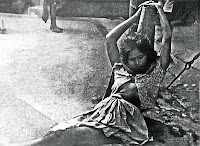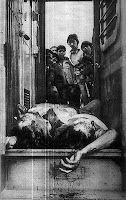
They collaborated with Pakistan's murderous, rapacious Army in 1971
This Friday, December 16, Bangladesh will celebrate the 40th anniversary of its victory in the 1971 Liberation War. The fall of Dacca, as Dhaka was then known, marked the end of Pakistani tyranny and the beginning of a new era for the Bengali nation. It also marked, with Lieutenant-General Amir Abdullah Khan Niazi, the commander of Pakistan’s rapacious, murderous Army which killed three million Bengalis in less than a year between March 26 and December 16, surrendering to the Indian Army, a splendid victory for our Armed Forces. Mrs Indira Gandhi fought that war out of deep moral conviction; Lieutenant-General JFR Jacob won the war displaying remarkable tactical skills and battlefield chutzpah. It was an equally splendid victory for the Mukti Bahini, the rag-tag army of freedom fighters, often armed with no more than antiquated .303 rifles.
Nothing could have been more appropriate to mark the 40th anniversary of the demise of Mohammed Ali Jinnah’s moth-eaten Pakistan, premised on his two-nation theory, that he had forged by holding a pistol to the head of India’s colonial masters and Congress politicians than to bring the razakars, the Urdu-speaking collaborators of the 1971 genocide of Bengalis, to trial. Not surprisingly, the razakars owed, and continue to owe, allegiance to the Jamaat-e-Islami. Those of them facing trial before the war crimes tribunal set up by the Government of Bangladesh have, over the decades, come to occupy exalted positions in that organisation which flaunts hate as its ideology.
There’s Delawar Hossain Sayedee, a senior Jamaat leader who spews venom everytime he opens his mouth. And there are five other razakars — Jamaat Ameer Motiur Rahman Nizami, secretary-general Ali Ahsan Mohammad Mojaheed and assistant secretaries-general Muhammad Kamaruzzaman and Abdul Quader Molla — who, along with him, willingly, actively, enthusiastically collaborated with the Pakistani soldiers in hunting down mukti joddhas, their families, intellectuals and political dissenters. In the dark of night they led Pakistani soldiers to villages where Hindus were dragged out from their homes — the men were killed, the women raped and bayoneted, young girls were carried away to Pakistani Army camps to be ravaged. Also facing trial are two senior leaders of Begum Khaleda Zia’s BNP whose dark past is now catching up with them.
Horrendous as the crimes committed by the Pakistani Army and the razakars against what was then East Pakistan’s Hindu minority community were, Bengali-speaking Muslims were not spared either. They were butchered in scores, then in hundreds, and when even that did not succeed in suppressing the Bengalis, they were massacred in thousands. Mutilated bodies were dumped into mass graves, or just left in fields to be feasted upon by dogs and vultures. Those who could escape the murderers and rapists in Pakistani Army uniform and the razakars fled to India, taking shelter in refugee camps in West Bengal.
The seeds of Bangla- desh’s struggle for liberation from Pakistan were sown in 1948, when a dying Jinnah tried to force Urdu as the official language on Bengali-speaking East Pakistan. The Bengalis resisted this enforcement and matters came to a head on February 21, 1952, when students of Dhaka University led a rally against the imposition of Urdu: Many were martyred. First General Ayub Khan and later General Yahya Khan thought guns were sufficient to dominate East Pakistan; both were wrong.
The fire turned into embers, those embers turned into a blaze when the criminally callous rulers of Pakistan, all of them from its western-wing, mocked at the misery of the Bengalis after a terrifying cyclone swept through East Pakistan in 1970, killing half-a-million people and leaving millions homeless and destitute. Sheikh Mujibur Rahman’s Awami League, riding the wave of outrage, swept the national election, winning 167 of the 169 seats in East Pakistan and a clear majority in the 300-member Pakistan National Assembly. Armed with this mandate, he demanded the Prime Minister’s post. Backed by the Army and Gen Yahya Khan, Zulfiqar Ali Bhutto of Pakistan People’s Party insisted he should get precedence over Sheikh Mujibur Rahman.
The stand-off ended on March 7, 1971, with Sheikh Mujibur Rahman declaring, at the historic Race Course Ground rally in Dhaka, “The struggle this time is for our freedom. The struggle this time is for our independence... Joy Bangla!” The slogan was soon to reverberate across both sides of Padma, rekindling emotional and cultural linkages that Jinnah had miserably tried to stamp out with his “Urdu and only Urdu” policy. The ghosts of Ekushe February had returned to haunt the inheritors of Jinnah’s pernicious legacy; the blaze had turned into an uncontrollable inferno.
Alarmed by the rapid unravelling of Rawalpindi’s control over Dhaka, Gen Yahya Khan despatched his trusted man, Gen Tikka Khan, known for his ruthlessness, to take charge as East Pakistan’s Governor. Between March 10 and 13, Pakistan International Airlines cancelled all its flights and deployed its fleet to ferry “Government passengers” to Dhaka. Undeterred by the impending crackdown, Sheikh Mujibur Rahman, hours before his arrest in the early hours of March 26, issued a statement, “Today Bangladesh is a sovereign and independent country... The Bengalis are fighting the enemy with great courage for an independent Bangladesh. May god aid us in our fight for freedom. Joy Bangla!”
Gen Yahya Khan thought he had an easy solution to the problem posed by Sheikh Mujibur Rahman. “Kill three million of them, and the rest will eat out of our hands,” he told a foreign correspondent. Gen Tikka Khan did precisely that. By the time Gen Niazi signed the surrender documents, Pakistani soldiers had slaughtered three million Bengalis. The blood of those innocent victims of terror stains the hands of the razakars who are still alive and around. They should have been tried and despatched to the other world long ago. But as the cliche goes, better late than never. Sheikh Hasina has initiated the process; the tribunal should now take it to its logical conclusion.
Recommended reading: Pakistani dictators by Tariq Ali.

















